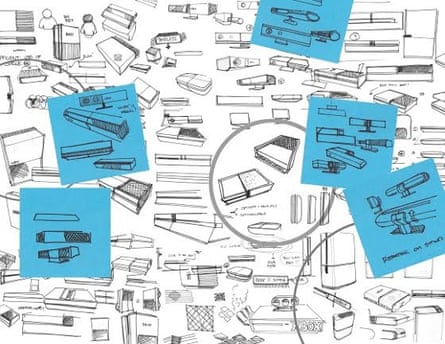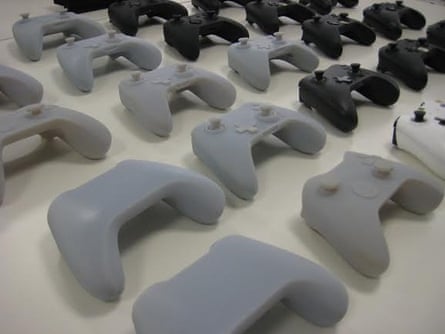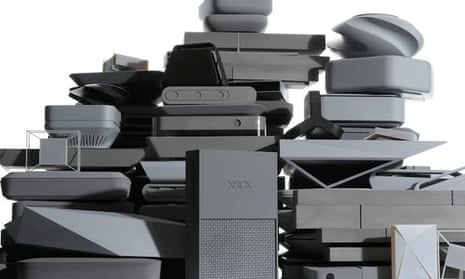You might not know Carl Ledbetter by name but you'll have seen his work. After all, it's plastered across billboards, nestling in living room cabinets and perhaps even wired up to your PC.
In his two decades at Microsoft, the veteran industrial designer has gone from crafting computer mice and keyboards to leading the team that designed the Xbox One, including its controller and the Kinect motion sensor. Meeting up with Ledbetter during a recent tour of the new Microsoft Studios HQ in London, we were able to ask about the origins of Xbox One, and its future.
Birth of a games machine
The concept for the console began with discussions about what exactly the phrase "next-generation" would mean this time around. Ledbetter and his team, based at the Microsoft campus in Redmond, needed to have an idea of what the games and other types of entertainment would like like, as well as the basic hardware architecture. "Once you start to conceptualise those two spaces then it's like, how does that come together? That provides the frame for the design team," he says.
"We looked at our heritage and identified goals for the new design to express all this new capability. We knew because it had more power and was going to be quieter, that the console would need to be a little bit bigger. How do we take that as a constraint and then create a body around it that's expressive?"

The heritage he talks of takes in the original Xbox, the Xbox 360 and the redesigned 360 with Kinect. The original was intended as a statement of raw power, with an intentionally other-worldly user interface. Ledbetter describes it as looking like the underneath of a Dodge pickup truck – a powerful engine. The 360, on the other hand, with its gently curving sides is referred to by Ledbetter as the "inhale before the strike", something more subtle, more about potential. Its more accessible user interface was intended to mirror the softer styling of the chassis.
To boldly go
With Xbox One, the guiding principle was apparently the phrase "boldly understated". "Xbox is doing more than it's ever done before and it's going to be used by more people than it's ever been used by before," says Ledbetter. "We kept thinking maybe it's more about all the new content that's coming and a little less about being the game box. That's where "boldly understated" concept came in."
The result is a black box which fits in with the rest of the systems and devices in your living room, but still has many subtle touches – texturing, different types of finish, responsive logo lighting... According to Ledbetter, it's all geared towards giving the machine its own unique identity while tying it to the overarching design language of Microsoft.
"We design hardware and software together," he says. So concepts for the onscreen dashboard, and the flow of the player from powering up to playing a game, were considered at length – all alongside the Kinect sensor design. "Even though this is a year and a half or two years before the hardware would ship, we had the software people conceptualising with us. It wasn't just 'go build a random piece of hardware and throw in the software'. They try to be perfect together."
Aspects of the physical design are therefore linked with the digital. Speaking generally, one of the recurring motifs across Microsoft's entertainment offering at the moment is the 16x9 aspect ratio offered up by HD TV screens. "That's the aspect ratio of entertainment," says Ledbetter. He points to the tile interface you'll find on the Xbox One dashboard and across Windows 8 devices. "If you take two of the tiles they're perfect squares but when you put them side by side there's a little bit of a gap so that [arrangement] turns out to be almost 16x9." Even Microsoft's new London offices pick up on the theme thanks to wall panels created with the same aspect ratio.
Looking at the Xbox One itself you get interface references like the white logo appearing from a black background – just as it does on-screen. The interface also impacted the design of the console's ventilation. "If you look at the vent details on the top of the console there's a little bitty frame that goes around the pattern. That was inspired by – or inspired – the software hover state. When you hover over a tile it creates this little frame."
The phrasing Ledbetter uses, "was inspired by – or inspired," betrays how closely linked the physical and digital are in the design process. "There's definitely one language, even in the smallest details: we use the same fonts on the labels inside the battery compartment on the controller as in the UI," says Ledbetter.
Peripheral vision
Looking beyond the main console you've got the controller and the Kinect sensor. The former hasn't had a massive design overhaul since the 360, but the team spent a lot of time tinkering to try to improve it, and it claims there have been 40 subtle improvements.
"About 50% of gamers are women so we started to do 'human factors' research on our controller. We wanted to create a form that would fit a wider range of hand sizes - that's what led to the removal of the battery bump underneath. We found that people were sensitive to up to a tenth of a millimetre in thickness and size changing on the controller too."
Human factors looks at how product design relates to the human body and its abilities. The Xbox One controller has thus been designed to be comfortable for hand sizes which fit into the 5-95 percentile range. Hands at the extremes of the size range will struggle but everyone else should be able to play comfortably. The emphasis here is on what suits the mass market and which hand sizes represent substantial proportions of the customer base.

Would the company be interested in creating controllers for smaller portions of the audience – perhaps for young children or more specialised designs for players with disabilities?
"We're definitely interested in it," says Ledbetter. "There are a couple of people on our team who have disabled family members. We're always looking at different ways to improve or change or evolve the way things work. Back in 2010 after we launched Kinect for 360, I received a letter from a woman whose son always wanted to play Xbox but couldn't because of disabilities. Then when the Kinect came out he was able to play games.
"It liberating – he could do some new things he couldn't do before. [With Kinect] it seems like we're just starting to scratch the surface of new types of things that hopefully more people can have access to."
As part of a group discussion earlier in the day the question of whether the Kinect was designed intentionally to look like a face also came up. "It was not intended to be a face – I can honestly say that!" says Ledbetter. "We knew we wanted that RGB camera to be off to the left and we knew that the infrared emitters – the gesture sensors – needed to be towards the middle. The RGB camera on the left was going to stand out so it became more about balance – how can we balance and offset the brand with the camera?"
Best before…
The Xbox One has been built with Microsoft's current product range and brand values in mind, as were its predecessors. But looking at the original Xbox, or even the first batch of 360s, not quite a decade old, they do feel dated. Is there any way that Ledbetter and his designers tried to futureproof the Xbox One?
"As industrial designers, everybody on our team strives to create things that are essentially timeless, that in ten years somebody might say 'Wow, it's classically beautiful.'"
But technological progress, and the way that affects consumer electronics, makes change part of the business. There are doubts about whether a games console cane ever be considered timeless – it always betrays something of its era, whether that's the wood-paneling on the side of the old Atari 2600, or the garish "16-Bit" badge on the top of the Sega Mega Drive.
"We know in a matter of years from now things are going to become more miniaturised, power is going to increase, experiences are going to change," says Ledbetter. "But we do know that [Xbox One] needs to hold up for 10 years.
"We try to create something that's very expressive of what we're doing right now and then we trust that the quality of the design is high enough it will stand the test of time."

Comments (…)
Sign in or create your Guardian account to join the discussion